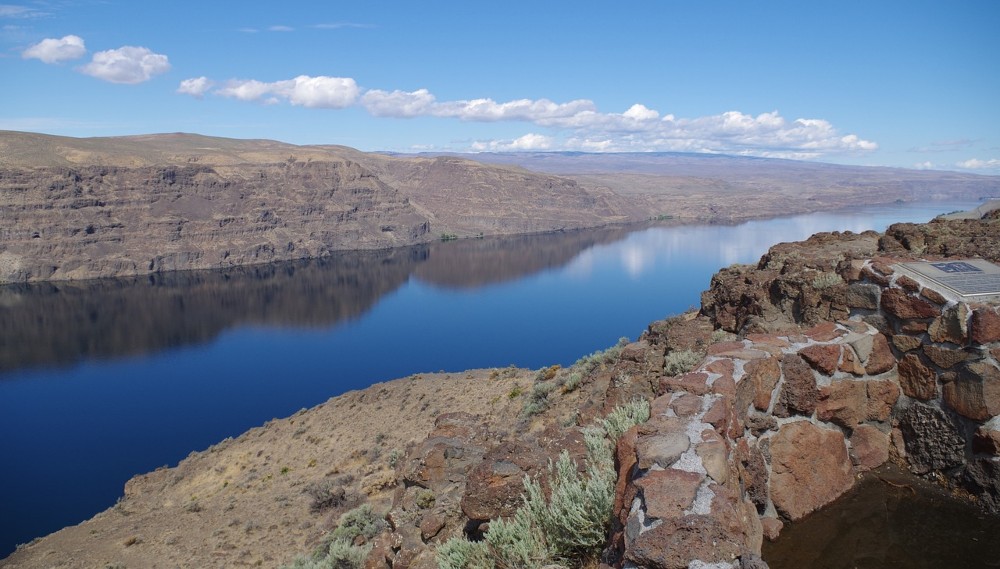In the 1950s, I occasionally drove through the dramatic Columbia River Gorge as a member of the Whitman College track team. My first views of this natural wonder were from the seat of a car jammed with bulky teammates enroute to track meets at Willamette University or Lewis & Clark College.
Later, I realized that we had been following an ancient trail taken by coastal Natives engaged in trade or warfare on either side of the Cascade Mountain Range. In 1805-1806, Lewis and Clark, Thomas Jefferson’s intrepid travelers, first charted the Gorge’s path and wonders. Later, trappers, voyageurs, and missionaries followed and mapped and described new details of this unique highway.
Some claim that the Gorge today is threatened by overdevelopment, although it is a protected national scenic site. Others, usually longtime residents of the Gorge, bemoan its underdevelopment. “La Grande Dalle de la Columbia,” was named by French voyageurs for the flagstone chutes or gutters along sections of the river’s route. Today, The Dalles, Oregon, an early waystation for steamboat and foot travelers, remains the portal for the Gorge’s soaring cliffs and rocky vistas.
During evening travel, dark shapes are bathed in reflected lights from the sky, small towns, and vehicle headlights. The darkness creates a tranquil, eerie path from the mists of Portland to the rolling Cascade foothills anchored at The Dalles. Celilo Falls, the historic Native fishing rapids, was flooded and erased by the l950s Dalles Dam (Meriwether Lewis referred to this busy meeting and fishing site as “the Great Mart”). Bonneville Dam, the first large man-made barrier, was constructed in the 1930s, changing the shoreline, inviting steamboat travel, and interrupting mountain streams. Despite human tinkering, the mighty Gorge’s shoulders remain broad and steadfast and they still nurture river otter, mariposa lilies, hillside licorice ferns, great salmon runs, and the giant (but threatened) white sturgeon.
Our Track and Field team occasionally stopped for a meal in Hood River, Oregon, at lumberman Simon Benson’s 1921 cliff-hanging Columbia Gorge Hotel. This romantic, stunning pile (with a waterfall running underneath) was at first visited by Hollywood celebrities and genteel visitors from large West Coast cities. Since then, it has become a favorite of all travelers.
Returning upriver, our 1950s teams usually stopped at Multnomah Falls Lodge, named for a since-disappeared Multnomah Native tribe. In my Whitman days another attraction at this famous site was a sign advertising gourmand-size plates of rare roast beef sandwiches, with a promise that you could help yourself to unlimited seconds and thirds. A few months after our hungry stops at the Lodge, however, the sign was removed, and the “unlimited” beef treats disappeared.
Upstream from Multnomah Falls, at the charming hillside town of Hood River, visitors can do “the loop” by bicycle, vehicle, or the small rattling Hood River train (offering lunch and brunch excursions). This meandering road roams through orchards, including the seasonal Harvest (Apple) Festival, and an endless string of roadside fruit stands midst orchards and vineyards protected by ancient green volcanic hills.
On one occasion, with my pre-teen son and nephew on board, I climbed Beacon Rock, the “plug” of an ancient volcano. Native stories cite this large monolith at the foot of Bonneville Dam as an historic lookout, shrouded in myth and mystery. After clinging to a cable on the Rock’s narrow and windy path, I experienced great relief to descend to my car in the little park at the foot of this grand peak.
Still today, the Columbia Gorge offers rare and memorable vistas, stories, watery noises, trails, and overlooks (many created by Italian stonemasons in the 1920s) without rival in our Great West.
Discover more from Post Alley
Subscribe to get the latest posts sent to your email.

Excellent memories come rolling back regarding the Gorge
Our favorite is the CHARburger in Cascade Locks.Too bad the National Scenic Act wasn’t written to preserve the eastern Landscape or ridges from Wind Turbine blight.
Many thanks for this enjoyable, personally flavored perspective! A thrill as always.
I really enjoyed your perspectives, which mix the history of the gorge with your own experiences. Delightful. Thank you.
It’s definitely a magical place. I went to the Wanapum park last Sunday for what is going to be one of my last floats (ie – old dude blissfully lying on an inflatable air mattress in clean water totally zoning out) of the year, and it was glorious.
For those who don’t know the location, you take the last eastbound exit from I-90 before you cross the Columbia at Vantage – it’s about 2-2 1/2 hours from Seattle depending how many stops you make and whether you go antique shopping at Thorp.